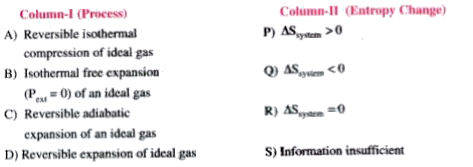The change in Gibbs free energy of the system along provides a criterion for the spontaneity of a process at constant temperature and pressure. A change in the free energy of a sytem at constant temperature and pressure will be: ΔGsystem=ΔHsystem−TΔSsystem
The free energy for a reaction having ΔH=31400 cal, ΔS=32 cal K−1mol−1 at 1000∘C isSolution in Telugu
−9336 cal
−7386 cal
−1936 cal
+9336 cal
The correct Answer is:A
ΔG=ΔH−TΔS
=31400−32(1273)=−9336 cal
Topper's Solved these Questions
- BOOK - AAKASH SERIESCHAPTER - CHEMICAL THERMODYNAMICSEXERCISE - LECTURE SHEET (EXERCISE-III) (LEVEL - II (ADVANCED) MATRIX MATCHING TYPE QUESTIONS)2videos
CHEMICAL THERMODYNAMICS
- BOOK - AAKASH SERIESCHAPTER - CHEMICAL THERMODYNAMICSEXERCISE - LECTURE SHEET (EXERCISE-III) (LEVEL - II (ADVANCED) INTEGER TYPE QUESTIONS)5videos
CHEMICAL THERMODYNAMICS
- BOOK - AAKASH SERIESCHAPTER - CHEMICAL THERMODYNAMICSEXERCISE - LECTURE SHEET (EXERCISE-III) (LEVEL - II (ADVANCED) MORE THAN ONE CORRECT ANSWER TYPE QUESTIONS)5videos
CHEMICAL THERMODYNAMICS
- BOOK - AAKASH SERIESCHAPTER - CHEMICAL THERMODYANMICS EXERCISE - Questions For Descriptive Answers28videos
CHEMICAL THERMODYANMICS
- BOOK - AAKASH SERIESCHAPTER - ELECTRON MIGRATION EFFECTS EXERCISE - QUESTIONS FOR DESCRIPTIVE ANSWERS10videos
ELECTRON MIGRATION EFFECTS
Similar Questions
 01:53View Solution
01:53View SolutionIn how many of the following entropy increases?
(a)N2(g)+3H2(g)→2NH3(g)(b)PCl5(g)→PCl3(g)+Cl2(g)(c)H2O(s)→H2O(g)(d)H2O(l)→H2O(g)(e)2NaHCO3(s)→Na2CO3(s)+H2O(g)+CO2(g)(f)NH2CO2NH4(s)→2NH3(g)+CO2(g)(g)H2O(l)→H2O(s)(h)CO2(s)→CO2(g)01:16View SolutionAll the antural processes in this universe produce
01:54View SolutionHow does heat of neutralisation value change with the chemical nature of acid and base?
01:03View SolutionHyperconjugation effect is also termed as 'no bond resonance'. Why?
01:09View SolutionA change in the free energy of a system at constant temperature and pressure will be:
ΔsysG=ΔsysH−TΔsysS
At constant temperature and pressure
ΔsysG<0 (spontaneous)
ΔsysG=0 (equilibrium)
ΔsysG>0 (non-spontaneous)
The free enegry for a reaction having ΔH=31400cal,ΔS=32calK−1mol−1at1000∘C isView SolutionThe changes in gibbs energy (Delta G) of a system for a process at constant temperature and pressure is
View SolutionThe change in Gibbs free energy of the system alone provides a criterion for the spontaneity of a process at constant temperature and pressure. A change in the free energy of a system at constant temperature and pressure will be :
ΔGsystem=ΔHsystem−TΔSsystem
The free energy for a reaction having
ΔH=31400cal,ΔS=32calL−1mol−1 at 1000∘CView SolutionThe change in Gibbs free energy of the system alone provides a criterion for the spontaneity of a process at constant temperature and pressure. A change in the free energy of a system at constant temperature and pressure will be : DeltaG_("system")=DeltaH_("system")-T DeltaS_(system") For a system in equilibrium, DeltaG=0 , under conditions of contant....
01:09View SolutionThe free energy for a reaction having DeltaH=31400 cal, DeltaS=32" cal "K^(-1)mol^(-1) at 1000^(@)C is:
08:47View SolutionThe change in Gibbs free energy (DeltaG) of the system along provides a criterion for the spontaneity of a process at constant temperature and pressure. A change in the free energy of a system at constant temperature and pressure will be: DeltaG_("system")=DeltaH_("system")-TDeltaS_("system") At constant temperature and pressure: DeltaG_("system")lt0 (Spontaneous) DeltaG_("system")=0 (equilibrium) DeltaG_("system")gt0 (non-spontaneous) Free energy is related to the equilibrium constant as: DeltaG^(@)=2.303RTlog_(10)K_(e) . Q. If b oth DeltaH and DeltaS are negative, the reaction will be spontaneous:
02:30View SolutionThe change in Gibbs free energy (ΔG) of the system along provides a criterion for the spontaneity of a process at constant temperature and pressure. A change in the free energy of a system at constant temperature and pressure will be:
ΔGsystem=ΔHsystem−TΔSsystem
At constant temperature and pressure:
ΔGsystem<0 (Spontaneous)
ΔGsystem=0 (equilibrium)
ΔGsystem>0 (non-spontaneous)
Free energy is related to the equilibrium constant as:
ΔG∘=2.303RTlog10Ke.
Q. A reaction has positive values of ΔHandΔS. From this you can deduce that the reaction:View SolutionThe change in Gibbs free energy (ΔG) of the system along provides a criterion for the spontaneity of a process at constant temperature and pressure. A change in the free energy of a system at constant temperature and pressure will be:
ΔGsystem=ΔHsystem−TΔSsystem
At constant temperature and pressure:
ΔGsystem<0 (Spontaneous)
ΔGsystem=0 (equilibrium)
ΔGsystem>0 (non-spontaneous)
Free energy is related to the equilibrium constant as:
ΔG∘=2.303RTlog10Ke.
Q. For a reaction to be spontaneous at all temperature.01:42View SolutionThe free energy for a reaction having DeltaH =31400 cal. DeltaS=32 cal K^(-1)mol^(-1) at 1000^(@)C is
02:50View SolutionShow that in a process at constant temperature and pressure, the Gibbs free energy change of a system, DeltaG=-TDeltaS_("total") .
00:45View Solution1000∘C पर एक अभिक्रिया जिसका ΔH=31400calΔS=32calK−1 mol−1 है उसकी मुक्त ऊर्जा है
01:20View Solution

